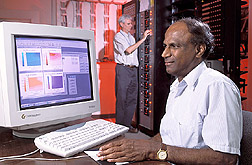This page has been archived and is being provided for reference purposes only. The page is no longer being updated, and therefore, links on the page may be invalid.
Read the magazine story to find out more. |
|
|
Computer Modeling Can Contribute to Thai Soybean Production
By Ann PerryOctober 26, 2009
Agricultural Research Service (ARS) scientists are testing the soybean model GLYCIM to improve its performance under a range of conditions around the world. In the process, they’ve been able to pinpoint the best agronomic practices for maximizing soybean production in Thailand.
GLYCIM was designed to simulate the growth of any soybean cultivar on any soil at any location and for any time of year. ARS research leader Vangimalla Reddy and soil scientist Dennis Timlin at the ARS Crop Systems and Global Change Laboratory in Beltsville, Md., partnered with scientists S. B. Lokhande and V.M. Salokhe, who work at the Asian Institute of Technology in Pathumthani, Thailand, to see how well GLYCIM estimated soybean yield potential in Thailand.
The team programmed GLYCIM with data from a field study conducted in Thailand that tracked soybean growth and yield. Then they introduced new data—including four years of weather measurements, seven planting dates, three soil types and three soybean cultivars—and developed 504 cultivation and yield scenarios for two key soybean production areas in northern Thailand.
The scientists already knew that high temperature stress could reduce soybean yields, and this study indicated that losses at the two Thai locations could be as high as 40 percent. GLYCIM results also indicated that it is critical for farmers to use optimal planting dates to achieve high yields at these sites. Planting on May 2 and May 16 produced the greatest yields, while earlier planting resulted in yield losses ranging from 7 percent to 17 percent. Yield losses in delayed planting simulations averaged around 30 percent.
These results further support GLYCIM’s use as a comprehensive mechanistic model for predicting soybean growth, development and yield across a range of agricultural systems. For instance, the model can help Thai farmers identify the best dates and soybean cultivars to obtain the highest yields, which could help increase production to meet current and future demand. Farmers in Thailand and other tropical regions could also use GLYCIM to estimate how different management practices could be adjusted to deal with the effects of global climate change and changing weather patterns.
This research supports the U.S. Department of Agriculture priorities of responding to climate change and promoting international food security.
ARS is USDA’s principal intramural scientific research agency.

